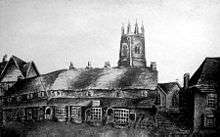Jacobite uprising in Cornwall of 1715
The Jacobite uprising in Cornwall of 1715 was the last uprising against the British Crown to take place in the county of Cornwall.
Background information to the event
On 1 August 1714, Queen Anne had died and George, Elector of Hanover, the son of the Electress Sophia, granddaughter of James I (1566–1625) was proclaimed King under the Act of Settlement of 1701. Naturally the legitimate heir James, son of James II of England, protested against this and those who believed in his rights took stronger steps than protestations, though they took a good year to get under way.
Events in Cornwall

The key characters of the Jacobite uprising in Cornwall were James Butler, 2nd Duke of Ormonde and Henry St John, 1st Viscount Bolingbroke. They were leaders of the High Tories. Part of their scheme was to capture Bristol, Exeter and Plymouth. With these important places in the hands of the Jacobites, they hoped that other smaller towns would join the cause. Ormonde had implicit confidence in Colonel Maclean, who had been sent to Devon and Cornwall to visit prominent members of the Tory party, and others likely to support the Pretender's cause. It turned out that Maclean was probably a spy who supplied the Ministry with names of Jacobite adherents, and measures were taken to prevent their committing mischief or folly.
On 22 September, John Anstis, MP for Launceston was arrested for plotting an uprising and on 6 October Sir Richard Vyvyan of Trelowarren, MP for Cornwall and the most influential Jacobite in the West, was taken and sent to London in the custody of a messenger.[1] On 7 October Mr James Paynter of Trekenning, proclaimed the Pretender in the market square at St Columb Major in Cornwall.[2] At this time the representative of the Government in Cornwall was Hugh Boscawen, of Tregothnan. This gentleman called out the militia and took measures which effectively put an end to any attempt at a rising. James Paynter and his servant along with fellow rebel, Henry Darr (also of St Columb) fled to London and remained undiscovered for some time. Paynter's servant at this time was sending letters to a sweetheart at St Columb and it seems that the postmaster suspected that the letter came from one of the suspects and inspecting the letter found that it come from London. Immediately warrants were ordered but they denied their names until eventually a messenger was sent to London who knew them particularly well and they were found to be the same persons.[3]
Some time later Paynter and his fellow rebels were sent to Newgate to be tried for high treason. Paynter claimed to be a judge in Cornwall, so he was tried at Launceston. Here Henry Darr died in the prison.[4] Eventually Paynter was acquitted by a packed Jacobite jury. Following the release of the rebels, friends appeared with white cockades in their hats (a Jacobite symbol), as a token of joy they were welcomed with 'bonfire and ball' all the way to Lands End .[5]
Proclamation at St Columb
In October 1716, the names associated with the proclamation of James III at St Columb were as follows: James Paynter, jun.; Thomas Bishop, gent.; Henry Darr, (bayliff and inn keeper); Anthony Hoskin, (pewterer); Francis Brewer, jun.; Richard Whitford, (barber); John Angove, (clothier); Richard Meter, (taylor).[6]
According to Henry Jenner, it seems probable that the postmaster who opened the letter from James Paynter's servant was no other than the celebrated Ralph Allen, afterwards of Bath. He certainly was at St Columb post office at that time and his distinguishing himself by his scrupulous performance may have been the beginning of his fortunes.[7][8]
In fiction
- Best, G M (2013). The Jacobite Murders. Robert Hale Ltd. Mentions the events in Cornwall.
- Lee, Katharine (1895). When Fortune Frowns. London Horace Cox. A fictional account based on historical facts of the Jacobite rising in Cornwall.
See also
- The following give a background to Cornish involvement in other rebellions.
- Cornish Rebellion of 1497
- Second Cornish Uprising of 1497
- Prayer Book Rebellion (1549)
- Monmouth Rebellion (1685)
- Bloody Assizes of (1685)
- The Glorious Revolution (1688)
- Sir Jonathan Trelawny, 3rd Baronet (1650–1721), one of the Seven Bishops tried under James II and the hero of the Cornish ballad, The Song of the Western Men
- Jacobitism
References
- ↑ Karkeek, P. Q. (1896). Jacobite Prisoners of the 1715 Rebellion. Devonshire Association for the Advancement of Science , Literature and Art. pp. 259–260.
- ↑ Sankey, Margaret Diane (2005). Jacobite Prisoners of the 1715 Rebellion. Ashgate Publishing, Ltd. pp. 9–10.
- ↑ A Faithful Register of the Late Rebellion: or, An impartial account of the impeachments, trials. Digital version from Oxford University, Ltd. 1718. pp. 350–352.
- ↑ http://www.cornwall-opc-database.org/search-database/more-info/?t=burials&id=2501701
- ↑ Gilbert, Davies (1838). The Parochial History of Cornwall.
- ↑ London Gazette No 5371 8–11
- ↑ Jenner, Henry (1921). "An incident in Cornwall in 1715". Journal of the Royal Institution of Cornwall. XX Part 7: 553–558.
- ↑ Tunstall, James (1848). Rambles about Bath, and its Neighbourhood. Simpkin, Marshall and Co. p. 119. Retrieved 7 September 2012.
Further reading
- Jones, George Hilton (1954). The Main Stream of Jacobitism. Cambridge Mass: Harvard University Press. [sic]
- Jacobitism and the English People, 1688–1788. Cambridge: Cambridge University Press. 1989.
- "Jacobitism in Cornwall". Old Cornwall. XI: 464–66. Autumn 1995.
- "The British Chronologist". 1775. p. 20.
- Tindal, Nicholas; Rapin-Thoyras, Paul de (1763). The Continuation of Mr. Rapin's History of England. p. 425.
- Charles, George History of the Transactions in Scotland in the Years 1715-16 and 1745-46 (1816)
External links
- Jacobitism in Devon
- PDF file of 'The Jacobite' Vol 2 No 5. 1923 Gives an account of the declaration at St Columb